Intelligent-Reflecting-Surface-Assisted Multicasting with Joint Beamforming and Phase Adjustment
Abstract
1. Introduction
2. System Model
3. Beamformer Design
3.1. LS-Based AP Pre-Coder Optimization
| Algorithm 1: AP pre-coder optimization algorithm |
|
3.2. IRS Phase Adjustment
| Algorithm 2: AP pre-coder optimization algorithm |
|
| Algorithm 3: decision algorithms |
|
4. Numerical Results
5. Conclusions
Author Contributions
Funding
Institutional Review Board Statement
Informed Consent Statement
Data Availability Statement
Conflicts of Interest
References
- Sidiropoulos, N.; Davidson, T.N.; Luo, Z. Transmit beamforming for physical-layer multicasting. IEEE Trans. Signal Process. 2006, 54, 2239–2251. [Google Scholar] [CrossRef]
- Chang, T.; Luo, Z.; Chi, C. Approximation bounds for semidefinite relaxation of max-min-fair multicast transmit beamforming problem. IEEE Trans. Signal Process. 2008, 56, 3932–3943. [Google Scholar] [CrossRef]
- Xiang, Z.; Tao, M.; Wang, X. Coordinated multicast beamforming in multicell networks. IEEE Trans. Wireless Commun. 2013, 12, 12–21. [Google Scholar] [CrossRef]
- Tran, L.; Hanif, M.F.; Juntti, M. A Conic Quadratic Programming Approach to Physical Layer Multicsting for Large-Scale Antenna Arrays. IEEE Signal Process. Lett. 2014, 21, 114–117. [Google Scholar] [CrossRef]
- Wang, J.; Xu, H.; Zhu, B.; Fan, L.; Zhou, A. Hybrid Beamforming Design for mmWave Joint Unicast and Multicast Transmission. IEEE Commun. Lett. 2018, 22, 2012–2015. [Google Scholar] [CrossRef]
- Wang, Z.; Ma, Y.; Li, H.; Li, M.; Liu, Q. Efficient Hybrid Beamforming for Multi-Group Multicasting in mmWave Systems. In Proceedings of the 11th International Conference on Wireless Communications and Signal Processing (WCSP), Xi’an, China, 23–25 October 2019. [Google Scholar]
- Abanto-Leon, L.F.; Hollick, M.; Sim, G.H. Hybrid Precoding for Multi-Group Multicasting in mmWave Systems. In Proceedings of the 2019 IEEE Global Communications Conference (GLOBECOM), Waikoloa, HI, USA, 9–13 December 2019. [Google Scholar]
- Sadeghi, M.; Bjornson, E.; Larsson, E.G.; Yuen, C.; Marzetta, T.L. Max–Min Fair Transmit Precoding for Multi-Group Multicasting in Massive MIMO. IEEE Trans. Wireless Commun. 2018, 17, 1358–1373. [Google Scholar] [CrossRef]
- Heath, R.W.; Gonzalez-Prelcic, N.; Rangan, S.; Rho, W.; Sayeed, A.M. An Overview of Signal Processing Techniques for Millimeter Wave MIMO Systems. IEEE J. Sel. Top. Signal Process 2016, 10, 436–453. [Google Scholar] [CrossRef]
- Han, S.; Xu, C.I.Z.; Rowell, C. Large-Scale Antenna Systems with Hybrid Analog and Digital Beamforming for Millimeter Wave 5G. IEEE Commun. Mag. 2015, 53, 186–194. [Google Scholar] [CrossRef]
- Molisch, A.F.; Ratnam, V.V.; Han, S.; Li, Z.; Nguyen, S.L.H.; Li, L.; Haneda, K. Hybrid Beamforming for Massive MIMO: A Survey. IEEE Commun. Mag. 2017, 55, 134–141. [Google Scholar] [CrossRef]
- Alkhateeb, A.; Ayach, O.E.; Leus, G.; Heath, R.W. Channel Estimation and Hybrid Prcoding for Millimeter Wave Cellular Systems. IEEE J. Sel. Top. Signal Process. 2014, 8, 831–846. [Google Scholar] [CrossRef]
- Ayach, O.E.; Rajagopal, S.; Abu-Surra, S.; Pi, Z.; Heath, R.W. Spatially Sparse Precoding in Millimeter Wave MIMO Systems. IEEE Trans. Wirel. Commun. 2014, 13, 1499–1513. [Google Scholar] [CrossRef]
- Wu, Q.; Zhang, R. Beamforming Optimization for Intelligent Reflecting Surface with Discrete Phase Shifts. In Proceedings of the ICASSP 2019—2019 IEEE International Conference on Acoustics, Speech and Signal Processing, Brighton, UK, 12–17 May 2019. [Google Scholar]
- Hu, S.; Rusek, F.; Edfors, O. Beyond Massive MISO: ThePotential of Data Transmission With Large Intelligent Surfaces. IEEE Trans. Signal Process. 2018, 66, 2746–2758. [Google Scholar] [CrossRef]
- Wu, Q.; Zhang, R. Intelligent Reflecting Surface Enahnced Wireless Network via Joint Active and Passive Beamforming. IEEE Trans. Wireless Commun. 2019, 18, 5394–5409. [Google Scholar] [CrossRef]
- Wu, Q.; Zhang, R. Towards Smart and Reconfigurable Environment: Intelligent Reflectig Surface Aided Wireless Network. IEEE Commun. Mag. 2020, 58, 106–112. [Google Scholar] [CrossRef]
- Yuan, X.; Zhang, Y.A.; Shi, Y.; Liu, H. Reconfigurable-Intelligent-Surface Empowered Wireless Communications: Challenges and Opportunities. IEEE Wireless Comm. 2021, 28, 136–143. [Google Scholar] [CrossRef]
- Cho, H.; Choi, J. Alternating Beamforming With Intelligent Reflecting Surface Element Allocation. IEEE Wireless Comm. Letters 2021, 10, 1232–1236. [Google Scholar] [CrossRef]
- Pan, G.; Ye, J.; Alouini, M.S. Full-duplex enabled intellignent reflecting surface systems: Opportunities and challenges. IEEE Wirel. Comm. 2021, 28, 122–129. [Google Scholar] [CrossRef]
- Abdullah, Z.; Chen, G.; Lambotharan, S.; Chambers, J.A. Optimization of Intelligent Reflecting Surface Assisted Full-Duplex Relay Networks. IEEE Wirel. Commun. Lett. 2021, 10, 363–367. [Google Scholar] [CrossRef]
- Abdullah, Z.; Chen, G.; Lambotharan, S.; Chambers, J.A. A Hybrid Relay and Intelligent Reflecting Surface Network and Its Ergodic Perforamance Analysis. IEEE Wirel. Commun. Lett. 2020, 9, 1653–1657. [Google Scholar] [CrossRef]
- Bjornson, E.; Ozdogan, O.; Larsson, E.G. Intelligent Reflecting Surface Versus Decode-and-Forward: How Large Surfaces Are Needed to Beat Relaying? IEEE Wirel. Commun. Lett. 2020, 9, 244–248. [Google Scholar] [CrossRef]
- Sharma, P.K.; Garg, P. Intelligent Reflecting Surfaces to Achieve the Full-Duplex Wireless Communication. IEEE Commun. Lett. 2021, 25, 622–626. [Google Scholar] [CrossRef]
- Zhou, Z.; Ge, N.; Wang, Z.; Hanzo, L. Joint Transmit Precoding and Reconfigurable Intelligent Surface Phase Adjustment: A Decomposition-Aided Channel Estimation Approach. IEEE Trans. Commun. 2021, 69, 1228–1243. [Google Scholar] [CrossRef]
- Zhao, M.; Wu, Q.; Zhao, M.J.; Zhang, R. Intelligent Reflecting Surface Enhanced Wireless Networks: Two-Timescale Beamforming Optimization. IEEE Trans. Wirel. Commun. 2021, 20, 2–17. [Google Scholar] [CrossRef]
- Wang, P.; Fang, J.; Yuan, X.; Chen, Z.; Li, H. Intelligent Reflecting Surface-Assisted Millimeter Wave Communications: Joint Active and Passive Precoding Design. IEEE Trans. Vehic. Technol. 2020, 69, 14960–14973. [Google Scholar] [CrossRef]
- Tao, Q.; Zhang, S.; Zhong, C.; Zhang, R. Intelligent Reflecting Surface Aided Multicasting With Random Passive Beamforming. IEEE Wirel. Commun. Lett. 2021, 10, 92–96. [Google Scholar] [CrossRef]
- Zhou, G.; Pan, C.; Ren, H.; Wang, K.; Nallanathan, A. Intelligent Reflecting Surface Aided Multigroup Multicast MISO Communication Systems. IEEE Trans. Signal Process. 2020, 68, 3236–3251. [Google Scholar] [CrossRef]
- Hwang, D.; Yang, J.; Kwon, K.; Joung, J.; Song, H. Equaliozation-Base Beamforming for Secure Multicasting in Multicast Wiretap Channels. IEEE Access 2021, 9, 33 826–33 835. [Google Scholar] [CrossRef]
- David, H.A. Order Statistics; John Wiley and Sons, Inc.: New York, NY, USA, 1981. [Google Scholar]
- Stuber, G. Principles of Mobile Communication, 5th ed.; Springer International Publishing AG: Cham, Switzerland, 2017. [Google Scholar]
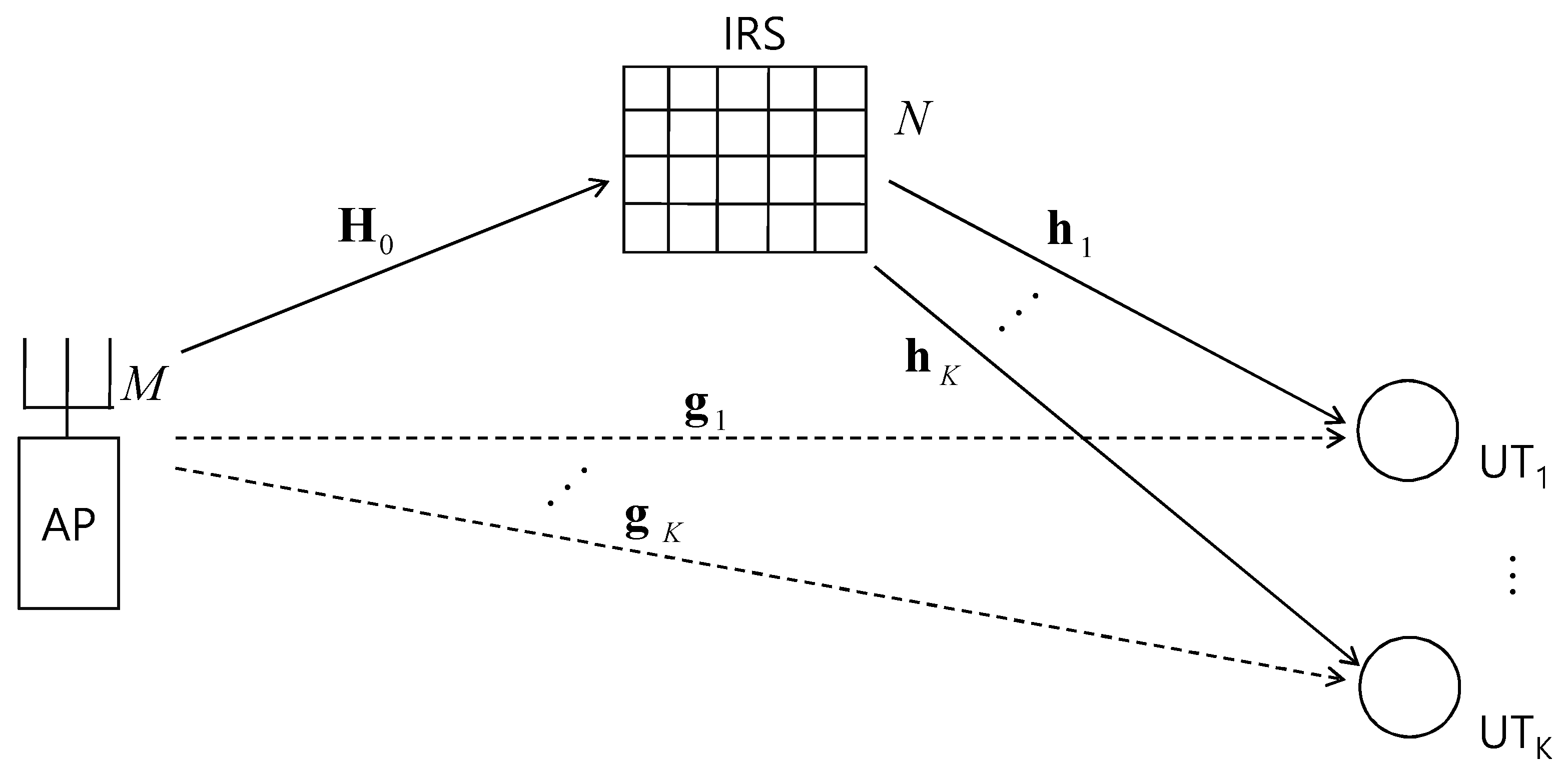
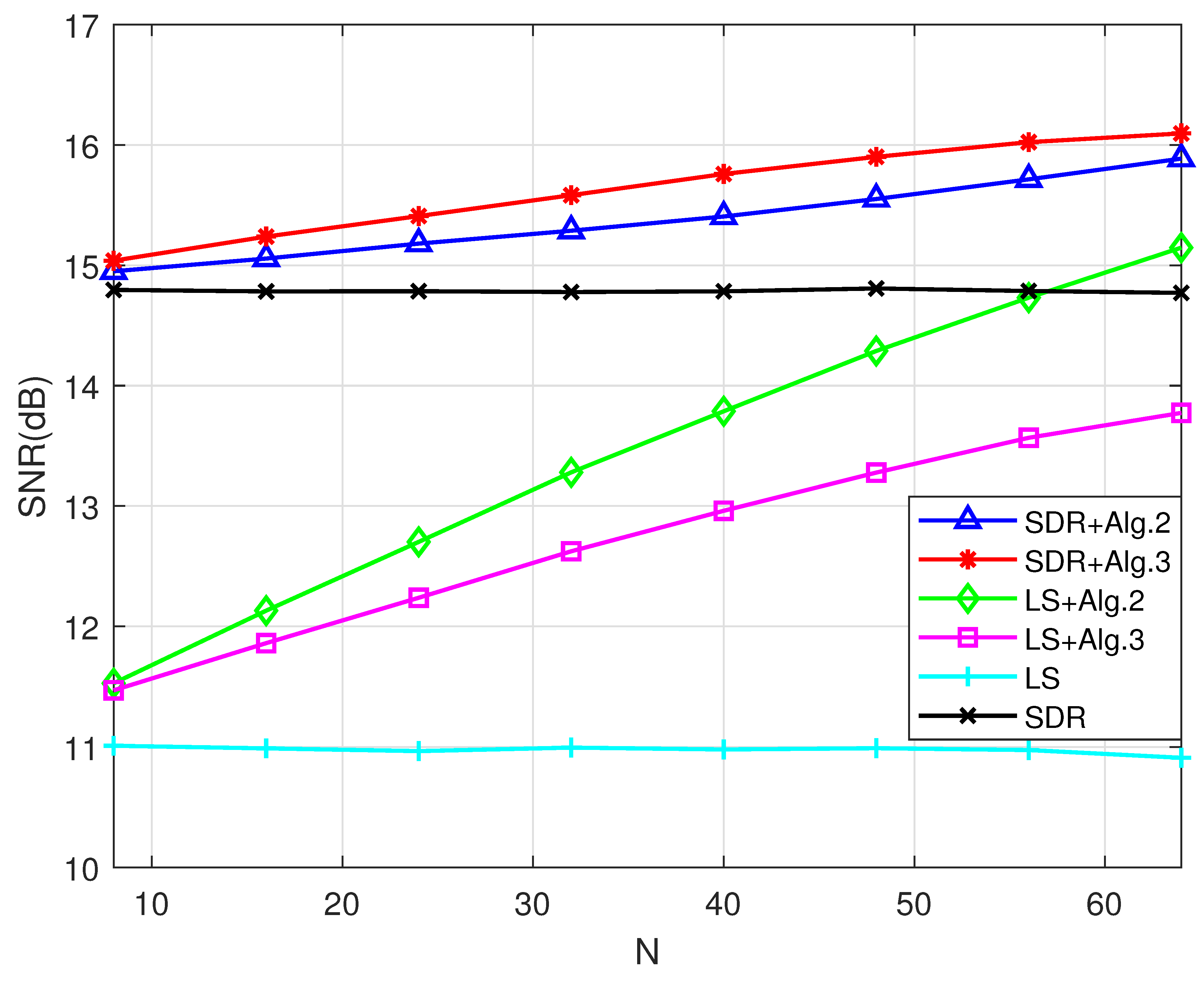
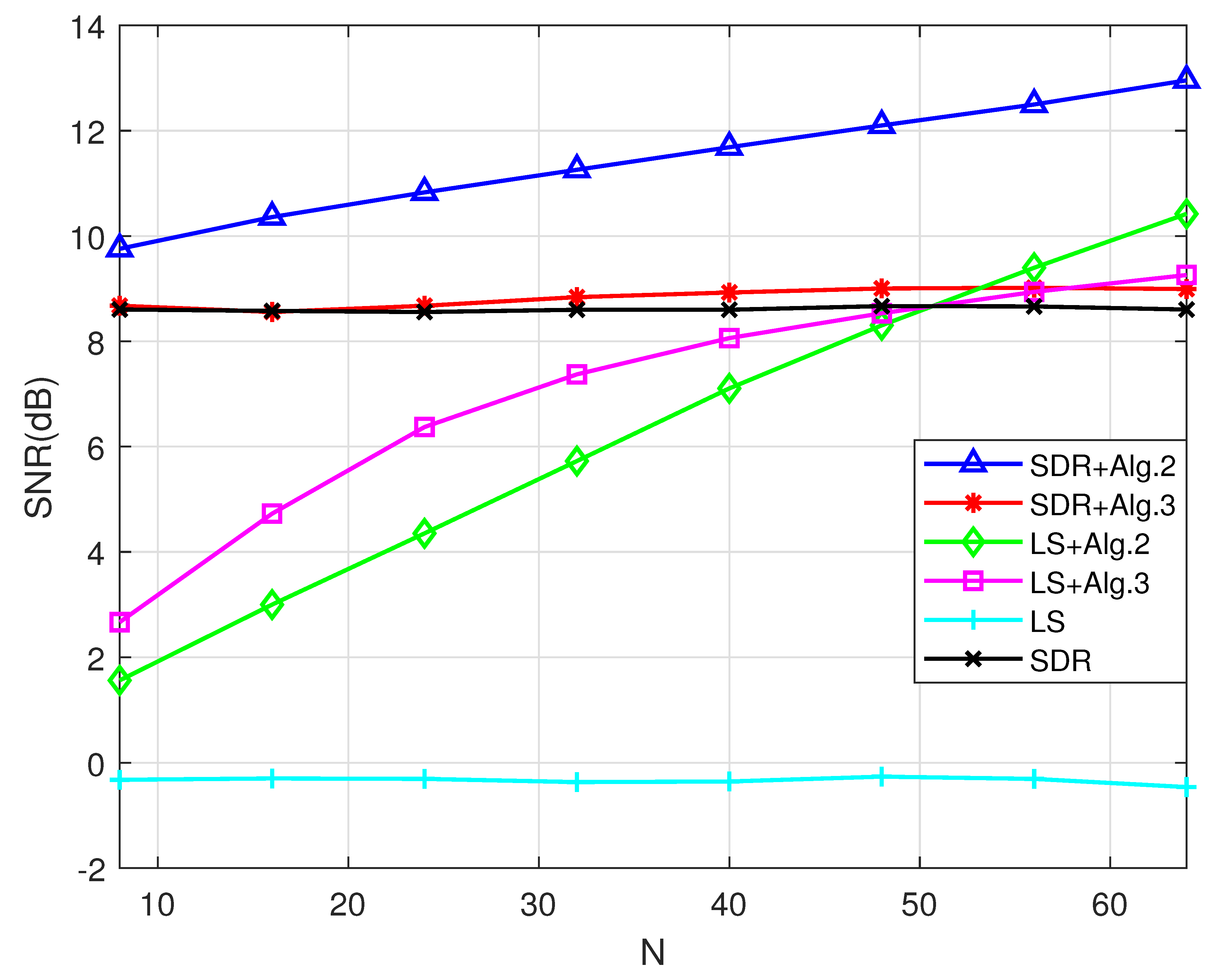
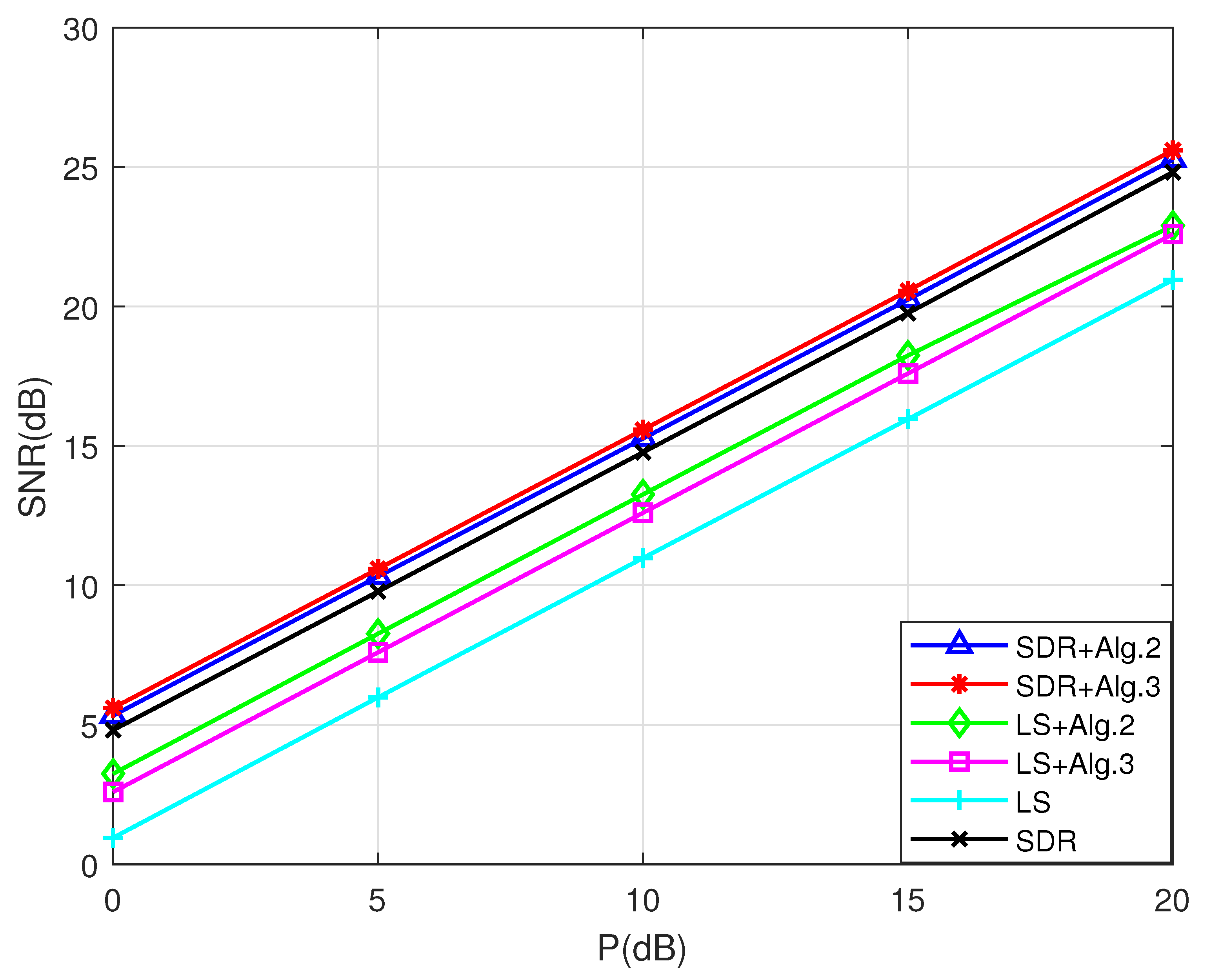
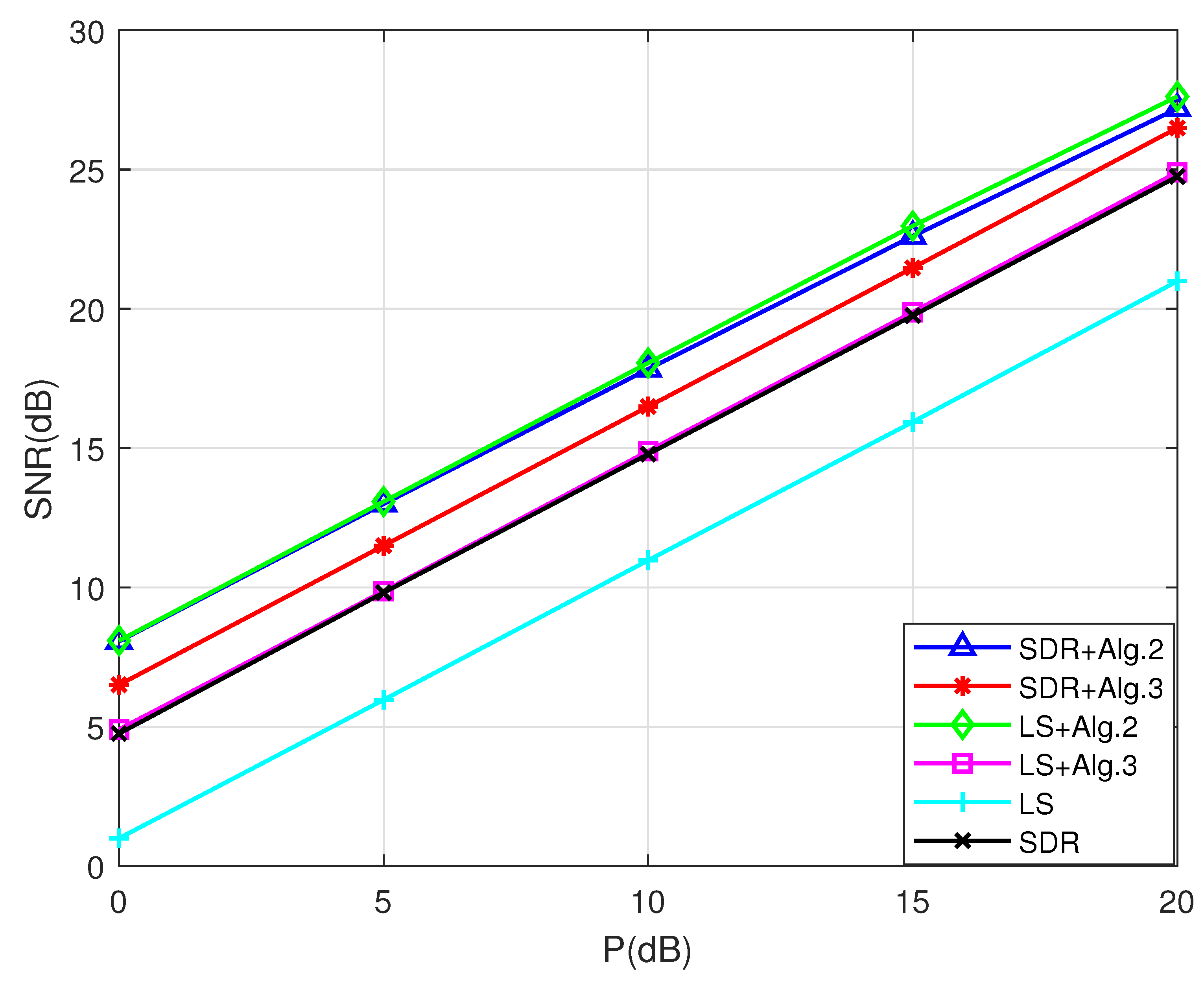
Disclaimer/Publisher’s Note: The statements, opinions and data contained in all publications are solely those of the individual author(s) and contributor(s) and not of MDPI and/or the editor(s). MDPI and/or the editor(s) disclaim responsibility for any injury to people or property resulting from any ideas, methods, instructions or products referred to in the content. |
© 2022 by the authors. Licensee MDPI, Basel, Switzerland. This article is an open access article distributed under the terms and conditions of the Creative Commons Attribution (CC BY) license (https://creativecommons.org/licenses/by/4.0/).
Share and Cite
Hwang, D.; Nam, S.S.; Yang, J.; Song, H.-K. Intelligent-Reflecting-Surface-Assisted Multicasting with Joint Beamforming and Phase Adjustment. Appl. Sci. 2023, 13, 386. https://doi.org/10.3390/app13010386
Hwang D, Nam SS, Yang J, Song H-K. Intelligent-Reflecting-Surface-Assisted Multicasting with Joint Beamforming and Phase Adjustment. Applied Sciences. 2023; 13(1):386. https://doi.org/10.3390/app13010386
Chicago/Turabian StyleHwang, Duckdong, Sung Sik Nam, Janghoon Yang, and Hyoung-Kyu Song. 2023. "Intelligent-Reflecting-Surface-Assisted Multicasting with Joint Beamforming and Phase Adjustment" Applied Sciences 13, no. 1: 386. https://doi.org/10.3390/app13010386
APA StyleHwang, D., Nam, S. S., Yang, J., & Song, H.-K. (2023). Intelligent-Reflecting-Surface-Assisted Multicasting with Joint Beamforming and Phase Adjustment. Applied Sciences, 13(1), 386. https://doi.org/10.3390/app13010386





